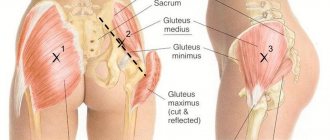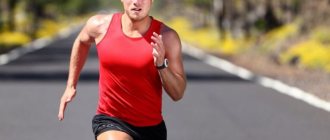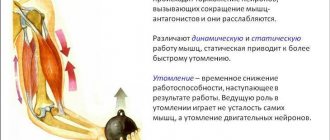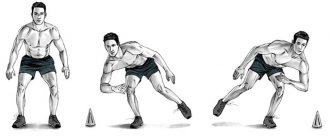≡ February 14, 2020 Category: Cardio
Cross-country running is running overcoming obstacles in the form of sharp turns, climbs, and other uneven terrain. Not everyone knows what this type of running is called among professional athletes. In sports literature it can be referred to as trail running, or simply trail.
What is cross running
Cross running is running over rough terrain, that is, along a natural route, on grass, dirt, hills. It could be a forest, a park, something like a golf course.
Cross running as a form of sports fun with certain rules was born in England in the 19th century. Cross country running participants had to be divided into two groups: imaginary hares and imaginary dogs. The “hares” ran away, leaving “traces” behind them, most often these were pieces of paper. The "dogs" had to track them down and catch up. The first races of this type began in the 1830s, and 30 years later, in 1867, national competitions for champion titles were approved.
Of course, the games took place in a natural area, because it fits the idea of a “hunt,” and there weren’t really any other places to run. This is roughly how cross-country running came into our modern times – a fast, active race in nature.
Basic Concepts
The main difference between cross-country is that the movement of athletes occurs outside of any sports facilities or specially prepared tracks. This condition is both an advantage of this direction of running and creates additional difficulties in mastering it. The advantage of cross-country training is that the athlete runs in more difficult conditions than during so-called “smooth” running. This kind of running forces all muscle groups to work actively and perfectly develops overall endurance. Athletics cross-country is considered an excellent way to improve the performance of athletes involved not only in athletics, but also in various other sports.
However, running over fairly rough terrain also requires some special training. The presence of various obstacles on the running route, ascents and descents encountered, the possibility of stumbling, stepping on a stone or tripping over a branch place increased demands on the physical condition of the practicing runner.
This is interesting
- [uaf_vkcount url='https://beginogi.ru/trenirovki-po-triatlonu-kak-podgotovitsya/']
Triathlon training, how to prepare?
- [uaf_vkcount url='https://beginogi.ru/sportivnaya-sumka-na-poyas-dlya-bega-kakuyu-vyibrat/']
Sports belt bag for running: which one to choose?
Features of cross running
To understand the characteristics of cross-country running, the easiest way is to compare it with trail running. Trail runs also run over hills and rough terrain, but trail runs are longer and the terrain is steeper. In the case of a trail, these are most often mountains, sometimes with a large climb and height difference. Trail running also occurs in deserts.
The distances on the trail are always longer, some races last hours and days. If you see a race of 12 kilometers or more in a natural area, then this is no longer a cross-country race - it is a trail.
Trail routes almost always take place where there are rivers, mud, and difficult terrain, which sometimes requires taking a step to pass. In cross-country running, there may also be rivers and muddy areas on the trails, but the competitions are held exclusively on the ground, even if it is hilly.
Subscribe to “Marathon Man” on Telegram. Announcements of articles and useful selections every week.
Cross running is an athletics discipline. It has general recommendations for the duration and features of the course, although strict international standardization is not possible. The International Organization of Athletics Federations (IAAF) gives only recommendations regarding cross-country running, so to speak - the ideal track.
What is trail running: features of trails, requirements for participants and equipment
photo: Running community
How to prepare?
So, we have found out the benefits of cross-country running, but don’t rush to immediately run for sneakers. First you need to figure out how to properly prepare for training and where to start.
First of all, choose a suitable location - let it be a flat surface without steep descents, ascents, sand and moving stones. Before starting each workout, do a warm-up - warm up your muscles and stretch your joints.
For the first couple of lessons, we recommend moving at a brisk pace in order to “scout” the situation and adapt to the load. Gradually increase your challenge by increasing the training time from 20 minutes to 1.5 hours, and making the route more difficult.
Types of cross running
Let us repeat that there is no internationally generally accepted standard for cross-country racing - the natural landscapes and weather conditions in different regions are too different. But the IAAF describes the ideal cross-country course this way:
- This is a typical forest park with relatively little elevation change or a typical golf course. By the way, cross-country races are often allowed on golf courses abroad. In general, a cross race is a natural area that, for example, a mountain bike can ride through.
- This is a sequence of natural obstacles in the form of hills and sometimes rivers that require the athlete to change his running tactics, but allows him to maintain an even pace. The sections with changing landscapes are approximately equal, but complex terrain prevails, that is, the flat sections are shorter than the hilly ones.
- This is a grassy track with a minimum of roads, ideally no roads or on dirt.
- These are circles from 1750 to 2000 meters. Such cycles are done at international competitions.
- The course must have between 400 and 1200 m of flat ground from the start to the first turn to avoid crowding and falls.
- The start occurs simultaneously for all participants from the same line or arc according to the judge’s shot.
- At the finish line, the runner crosses the line and goes down a separate corridor, as in any running competition.
- Cross-country races are held in spring or autumn.
This is what a classic cross-country race looks like. Distances and terrain, as well as weather conditions, vary from one competition to another. But most often, cross-country distances are no more than 12 kilometers.
Some classifications include cross-country running and trail running, as well as a new type of mountain running – skyrunning. But we would argue with such a classification, since these races have different equipment, goals and terrain, which changes the very essence of cross-country running.
But cross-country running can easily be classified as sports orienteering - running with elements of terrain orienteering. The participants' task is to find checkpoints, check in on them and at the same time overtake their opponents. But the distances on them can be longer than usual cross-country races. Plus there is no strict direction of the route. Runners can reach the point in any way as long as they don’t get lost.
Trail running: impact on the human body
As motivation, it will be useful to know how trail running affects the human body.
Core muscles
The natural nature of the trails - soft, forgiving surfaces with occasional obstacles in the form of roots or rocks - engages the core to maintain body stability. Therefore, every step taken works to tighten and strengthen the core - the muscles of the middle part of the body .
Core muscles (responsible for stabilizing the pelvis, hips and spine)
Quadriceps femoris
Trail running, and downhill running in particular, strengthens and shapes your quadriceps . They act like brakes to keep you from spiraling down too quickly.
Gluteal muscles
Running uphill makes your butt . In addition, negotiating narrow paths with obstacles forces the gluteal muscles to actively work to maintain stability .
Calf muscles
Hilly terrain and/or running on particularly difficult routes engages the calf muscles - thanks to them, you can move forward. Every step that requires stability on the trail (this is almost the entire route) begins with the muscles of the foot and lower leg - the calf muscles .
Working the calf muscles while running
Connective tissues
Due to the constant need to maintain stability while running along a route - finding a smoother surface, as well as avoiding obstacles, helps strengthen the connective tissue in the body with each new step taken. This means that the ligaments and tendons surrounding the ankle, knee and hip joint become stronger and less susceptible to various injuries .
Joints
From grass and sand to packed dirt, soft trail surfaces are gentler than asphalt , which places stress on your joints with every step you take.
Trail running is not only gentle on your joints, but also strengthens them.
The beneficial effects of running in a forest belt on joints
Heart
Trail running strengthens your heart. A consistent variety of natural, aerobic exercise increases cardiovascular endurance, but not in the same way as trail running or treadmill running . For example, clean mountain air strengthens the heart, treats bronchial asthma, and restores the nervous system.
General physical condition
Research shows that running on natural terrain burns 10% more calories than running on flat trails.
Considering all the benefits described, it is safe to say that trail running will certainly make you stronger, leaner and healthier .
The impact of trail running on general physical condition
Distances in cross-country races
The length of cross-country races is usually from 3 to 12 kilometers. Again, distances differ from one particular race to the next. Let's take the competitive standard again as a basis.
Athletes do three to six laps ranging from 1,750 to 2,000 m in length, depending on the race and the age of the participants.
Adult distance – 12 km. Seniors compete in 10 km distances. Boys compete in 8 km races, and girls compete in 6 km races.
Amateur cross-country racing is essentially based on these standards. You can consider one of the most popular Moscow races - the Fox Mountain cross-country race. It is held in the Bitsevsky Forest Park. The track is built from circles of 2 kilometers, the maximum distance is 8 km, that is, four circles. Organizers describe the course as dirt with some puddles and mud.
Test procedure
The cross-country course is laid out in a park, forest or any open space on slightly rough terrain.
The starting point may be at the stadium. The cross can be carried out along a closed route (start and finish in one place) or along an open route (with start and finish in different places) in one or several circles of varying lengths.
A group of participants line up 3 meters before the starting line. The assistant starter calls the participant, who calls his number.
At the command “Start!” Participants take their places in front of the starting line.
After the starter fires from a pistol, or the command “March!” they start moving. The result is recorded when the participant finishes.
The maximum number of participants in the race is no more than 20 people.
Cross running technique
The fundamentals of cross-country running technique are not much different from conventional running techniques - the requirements for arm and leg movements are the same. Meanwhile, the physics of running will change throughout the distance, depending on whether you are running uphill or downhill, and the degree of load and running mechanics will also change.
Unlike road running, cross-country running has a different foot placement. In cross-country running, the leg is lowered to the ground with the entire foot and even with a special emphasis on the heel. First of all, you can’t run down a hill from your toes. Secondly, the larger area of the foot provides greater stability on slippery grass or mud.
In general, in a cross-country race, a runner is required not so much to have perfect technique as to instantly change tactics and be able to see what is under his feet. Roots, rocks, cones, puddles and mud force athletes to quickly figure out exactly where to place their feet, rather than how.
photo: Nattrass/Getty Images, source: runnersworld.com
A cross-country runner requires great strength and endurance in the legs, ankle joints, and hip muscles to overcome hilly obstacles. You need developed core muscles to help maintain balance and stability.
So it makes sense for cross-country participants to focus on general physical fitness, strength training, plyometric exercises, and pay attention to training stabilizer muscles, strengthening the muscles of the foot and core. It also makes sense to do explosive exercises like burpees, squat jumps, and jumping lunges.
Another aspect of preparation is that you won’t be able to run cross-country well if you don’t train on rough terrain. You can learn to run on grass, uneven roads, and jump over roots and holes only if you run in a forest park or forest.
During the race itself, an individually selected race strategy is important. The peculiarity of the route, which starts from a flat section, allows you to start quickly, and with proper preparation and proper distribution of forces during the race, you can maintain the same pace throughout the entire distance - with intense work, running up the hill and resting on the way down the hill.
Movement technique
Long running over rough terrain is called cross-country; it requires the athlete to be well prepared and follow the recommended technique. It will come in handy when fatigue appears due to long-term exercise, which, combined with uneven terrain, provokes an increased risk of injury.
The cross-country running technique is, in general, similar to the algorithm for standard races, but there are some peculiarities. For example, to maintain balance and control coordination, you will have to help yourself with your hands, tilt your body, alternate the pace and length of your step, and place your feet in different ways.
Changes in terrain load different muscle groups, so the technique of running up and down differs.
- When climbing uphill, you can slightly lean your body forward, but do not force it. We recommend shortening your step length and vigorously helping yourself with your hands.
- The descent is an equally difficult part of the distance, but not so energy-consuming. Therefore, it is easier to run down, but the risk of injury is much higher. It is better to straighten the body and even tilt it back a little. Do not lift your feet high from the ground, run in small, frequent steps. Bend your arms at the elbows and press them to your body. Place your foot first on the toe, then roll it onto the heel. The exception is loose soil - in these conditions, stick your heel into the soil first, then your toe.
The benefits of cross running
Cross running develops the cardiovascular system and lungs, and preparing for it helps you lose weight, tone your muscles and develop their strength. Targeted preparation for cross-country helps to develop explosive strength and power, to “draw” muscle relief, especially on the legs.
But the main highlight of cross-country running is that for a serious participant, this is a real physical and psychological test of endurance, strength, and endurance. Forcing yourself to run up the hill to the very end without slowing down takes focus and discipline.
Features of running on a natural landscape
Cross-country running is also called “trail running,” which literally means “running route” in English. Natural terrain is considered more natural for the human body than asphalt or a sports track. However, this does not mean that such a load will be easier for him - running requires maximum concentration and attention from the athlete. The constantly changing route does not allow the body to get used to the load, so the muscles are constantly toned.
This sport requires the athlete to have a developed sense of balance, the ability to feel his body, every muscle and joint. Both endurance and the ability to make decisions on the fly will come in handy.
Features of choosing equipment
Cross-country races do not require additional equipment. On the contrary, you need to run them lightly - backpacks are not used at cross-country races, nor are running bags, because during classic races you can do without water and without snacks.
The peculiarity of equipment for cross-country shoes is only in the selection of shoes. These should be trail sneakers, that is, with good tread, or spikes.
It makes sense to take sneakers with a water-repellent coating, such as GoreTex. Pay special attention to the toe part of the sneakers: it would be nice if they had toe protection, Toe Protector - from traumatic impacts on stones or roots. Also, this part of the shoe should be spacious enough to provide enough room for your toes when running downhill.
Otherwise, the recommendations for selecting equipment for races are the same as for any competition. Shoes half a size larger, sportswear appropriate for the weather, seamless running socks.
By the way, at many cross-country courses it is forbidden to run with headphones in order to hear what is happening around you. It is not allowed to run without T-shirts to reduce the risk of injury in case of possible falls.
Nordic walking – Stavgång
Nordic walking first emerged as an independent fitness trend in Sweden, which is why it received this name. This type of walking is also called Swedish or Finnish walking.
Nordic walking with poles: technique:
Swings of the arm and steps of the same leg should be synchronized. While walking, you should not stretch your arms forward too much. It is better if the stick is slightly tilted towards you. It is necessary to maintain an energetic pace and take springy steps. First you need to stand on your heel, then on your toes. In this case, the correct load on the muscles of the thighs and buttocks is ensured. It is necessary to choose the right walking poles: they must have special straps and a suitable length. During Nordic walking, you need to push off with poles with sufficient effort. It is necessary that the chest, shoulders and hips are in motion along with the legs and arms.
The benefits of Nordic walking
Walking with poles provides a constant, but not excessive load, which allows you not to overload the body with training. This type of fitness has virtually no contraindications.
Allows you to burn almost 50 calories more than regular race walking. Improves metabolism. Increases the body's endurance. Allows you to train 90% of the muscles of the body without harm to health. Helps people suffering from injuries and damage to the musculoskeletal system return to a full life. Walking with poles strengthens the immune system
Another benefit of Nordic walking is that the knees are subject to minimal stress. This is especially true for older people and obese people, for whom serious physical activity is not recommended.
Nordic walking techniques, in detail:
Alternating steps are the simplest technique with which it is recommended to begin acquaintance with Nordic walking for beginners. Used for a full body workout. The simultaneous step is the second most difficult style, which is recommended to be mastered after mastering the basic skills. When walking in this technique, the shoulder girdle is subjected to increased load. “Cat walk” is a special technique that can be used to minimize the load on the joints and spine. Christmas tree technique - used after mastering basic techniques, and is used when walking on very rough terrain, mountains, and ravine slopes.
Alternating step - execution technique
Alternating stride is very similar to regular skiing. In this case, the movements of the legs and arms are performed in the following order:
The right leg is brought forward, the arms remain relaxed and slightly pulled back. The foot is lowered to the surface on the heel. The left arm is brought forward at the shoulder line, fixed in a vertical position at the intersection of the lines of the shoulder and the foot brought forward. The foot of the right foot is smoothly transferred to the toe. At this time, the left leg is brought forward and placed on the heel. The left hand pushes off while moving the legs. At this time, the right hand is brought forward, the stick is installed vertically in line with the shoulder and the foot placed forward. The foot of the left foot is smoothly transferred to the toe, the right leg and left hand are brought forward again.
Simultaneous step - execution technique
Simultaneous Nordic walking differs from alternate walking only in the movements of the arms. At its core, it completely repeats the classic skiing move, when pushing off occurs with both hands at the same time. In this case, as in the previous case, the legs are first placed on the heel and then smoothly rolled onto the toe. In this case, the sticks are installed closer to the heels, and, if necessary, move forward 50 centimeters or more. At the same time, the body tilts slightly forward. When pushing off, the weight of the athlete should be transferred to them as much as possible.
Cat walk - technique
This Nordic walking technique is used when the load needs to be redistributed so that the knees and spine are not exposed to excessive stress. It is usually practiced during rehabilitation after injuries or joint surgeries. The technical execution of the “cat walk” almost completely repeats the alternating step. The difference is that you need to pull your head up the entire time you walk. At the same time, you should not raise your chin - it should be located at a right angle to the neck. Your back should also be kept as straight as possible.
Christmas tree walking technique
This Nordic walking technique is used when walking up steep ascents and descents. With this type of walking, the legs are placed wider than with alternating and simultaneous walking, and the toes are slightly spread to the sides. The sticks are also placed wide enough so that they do not interfere when moving the legs. The load should fall on the inner arch of the foot, the step should be alternating. If a person has problems with the joints of his legs, he needs to switch to a simultaneous walking technique, and try to redistribute the load to his arms.
The most common mistakes:
Using ski poles. Firstly, they are not as durable as special Nordic walking poles. Secondly, they are not equipped with straps that secure the hand in the desired position. Thirdly, they do not absorb shock, and therefore the load is not distributed as needed. Using poles that are too long or too short. Under no circumstances should they cross behind the back, much less force the person to slouch during repulsion. Rotation of the body when pushing off with a stick. This can increase the load on the spine, which is extremely undesirable. Repulsion is carried out by pressing on the stick with the hand. To use the muscles of the limb, you need to press the stick with your entire elbow. An erratic step, which very often leads to falls and injuries.
How to increase the effectiveness of Nordic walking training
Increasing the distance traveled
Naturally, the more we walk, the more calories we burn.
Cross country training
Walking on hilly and/or uneven terrain, such as walking on trails, grass, sand, gravel, snow or maneuvering through trees, descents/ascents, activates the core muscles, burns more calories and strengthens muscles. For example, a 5% incline increases calorie burning by 50%. If you are a beginner, avoid steep hills. Walking in the snow increases the number of calories burned by 2-3 times. If you get a second wind walking on an asphalt road at the end of a long walk, it may be because walking on asphalt or concrete requires less energy than walking on dirt or sand.
Walking with extra weight
As you increase your fitness level, you can try weight walking. This must be done very carefully, as extra pounds create additional stress on the joints. But if you still decide to do this, you should add no more than 10 kilograms and carry this additional load in a backpack or, evenly distributed, in an unloading vest.
Increased arm movement
Walking speed largely depends on the movement of your arms. Swinging your arms generates energy and movement that propels you forward, helps you burn more calories, and strengthens your upper body muscles.
Good posture
Walking with good posture means that the muscles in your back and buttocks work more powerfully. Therefore, you will be able to walk faster and burn more calories.
Abdominal muscles
Some experts believe that the abdominal muscles are most effectively trained while standing. To maintain good posture and tone your abdominal muscles, pull them in and up, but continue to breathe normally. Don't hold your breath.
Increase your stride length
The best way to walk quickly is to increase your steps. But to add variety and work to your leg muscles, increase your stride length. By taking long steps, you strengthen your inner and outer thigh muscles.
Add interval training.
Nothing burns fat better than interval training, which is an alternation of short vigorous and weak physical activity. For example, you can walk at a moderate pace for 5 minutes, and then walk at a brisk pace for 1 or 2 minutes (just below the point where you break into a run). Then return to your normal pace, recover for 5 minutes and repeat the acceleration. This will enhance your fat burning process, increase your fitness level, increase your walking speed and keep your metabolism higher for several hours after your workout.
How many steps do you need to take during Nordic Walking training?
The average person needs to take ten thousand steps a day to feel good. It is generally accepted that this is the case, but it is not clear whether this is a lot or a little, and in general, why exactly so much? The recommendation for 10,000 steps first appeared in an advertisement for a pedometer released in the 1960s in Japan.
10,000 steps is an hour and a half of continuous fast walking ; after walking 5,000 steps you will burn 170 calories , so let everyone determine for themselves based on their calorie consumption
, so let everyone determine for themselves based on their calorie consumption . Walking 10,000 steps is wonderful. However, if, as a reward for the distance you have walked, you decide to treat yourself to a burger with an energy value of 500 kcal, then this walk will not add any slenderness to your body. It will make even less sense if you are used to eating fast food regularly.
. Walking 10,000 steps is wonderful. However, if, as a reward for the distance you have walked, you decide to treat yourself to a burger with an energy value of 500 kcal, then this walk will not add any slenderness to your body. It will make even less sense if you are used to eating fast food regularly.
Table of calorie content of foods and dishes.
Porridge
The need to count calories applies to all nutrition groups. For example, it is generally accepted that cereals and pasta are complex carbohydrates and do not harm the body in the process of forming a healthy body, but nutritionists warn that eating cereals in large quantities can cause an effect that is completely opposite to losing weight and building a high-quality body. The correct dose of a particular food product can be calculated by calculating the calorie content of your diet.
| Buckwheat | 137 |
| Cornflakes | 372 |
| Semolina | 77 |
| Oatmeal | 93 |
| Cereals | 358 |
| Barley porridge | 102 |
| Millet porridge | 92 |
| Rice porrige | 79 |
| Barley porridge | 84 |
| Barley flakes | 345 |
Sausage and sausage products
| Boiled sausage Doctorskaya | 257 |
| Boiled sausage Lyubitelskaya | 311 |
| Boiled milk sausage | 243 |
| Half-smoked sausage Lyubitelskaya | 428 |
| Moskovskaya semi-smoked sausage | 402 |
| Semi-smoked sausage Servelat | 423 |
| Uncooked smoked sausage Lyubitelskaya | 511 |
| Raw smoked sausage Moscow | 476 |
| Raw smoked sausage Servelat | 453 |
| Hunting sausages | 325 |
| Krovyanka | 261 |
| Salami | 576 |
| Beef sausages | 215 |
| Pork sausages | 330 |
| Beef sausages | 229 |
| Chicken sausages | 242 |
| Sausages Amateur | 318 |
| Dairy sausages | 260 |
| Pork sausages | 284 |
Butter, margarine, fats
| Chicken fat | 896 |
| Rendered pork fat | 882 |
| Creamy margarine | 746 |
| Table milk margarine | 744 |
| Mayonnaise 67% | 624 |
| Flaxseed oil | 898 |
| Olive oil | 898 |
| Sunflower oil | 899 |
| Butter 82.5% | 747 |
| Ghee | 885 |
Butter, margarine, fats
The lack of a sufficient amount of protein in the body will make the body thin and loose, and certainly will not allow one to achieve high-quality body weight. Many experts recommend starting to lose weight and burn fat, if you don’t have too many kilograms, by building muscle mass. This approach is quite effective, since muscles are energy-intensive tissue of the body. If your body has enough developed muscles, then even at rest the number of calories consumed by the body will be high. This is due to the fact that muscles are literally penetrated by the circulatory system and require constant nutrition and breathing, which means that the energy costs for their maintenance in the body are high. Adipose tissue, on the contrary, does not require large expenditures of energy for its maintenance, since it is an emergency depot of energy “for a rainy day.” The same table of energy value and calorie content of foods will help increase the content of proteins and proper carbohydrates in your diet. You can calculate the daily value of calories needed by the body in a general way using simple calculations.
| Yogurt 1.5% | 65 |
| Yogurt 3.2% | 87 |
| Kefir 0% | 29 |
| Kefir 1% | 37 |
| Kefir 2.5% | 51 |
| Kefir 3.2% | 57 |
| Milk 0% | 34 |
| Milk 1% | 43 |
| Milk 2.5% | 53 |
| Milk 3.2% | 58 |
| Raw goat milk | 71 |
| Raw cow's milk | 63 |
| Skim milk | 30 |
| Whole milk powder | 477 |
| Condensed milk | 139 |
| Curdled milk 3.2% | 57 |
| Ryazhenka 2.5% | 53 |
| Ryazhenka 4.0% | 68 |
| Cream 10% | 121 |
| Cream 20% | 209 |
| Sour cream 10% | 118 |
| Sour cream 15% | 163 |
| Sour cream 20% | 208 |
| Curd cheeses | 344 |
| Dutch cheese | 352 |
| Poshekhonsky cheese | 348 |
| Russian cheese | 366 |
| Sulguni cheese | 293 |
| Fat cottage cheese | 236 |
| Low-fat cottage cheese | 89 |
| Cottage cheese semi-fat | 156 |
Meat, poultry
Meat and offal have a lot of pleasant preparation variations that can easily replace sausages from the store. At the same time, the saturation of the body when consuming homemade cutlets, blood and other homemade sausages, simply stewed or even grilled meat is simply colossal in comparison with the saturation that comes with eating a sausage sandwich from the store. Nevertheless, uncontrolled consumption of meat dishes cannot have a positive effect on the figure and health of the body as a whole. Since 100 grams of meat products contain an average of 200 kcal. To correctly build your daily diet, you should constantly refer to the calorie table.
| Mutton | 201 |
| Lamb Kidneys | 78 |
| Lamb Liver | 102 |
| Lamb Heart | 85 |
| Beef | 191 |
| Beef Brains | 126 |
| Beef liver | 100 |
| Beef Kidneys | 67 |
| Beef Udder | 176 |
| Beef Heart | 89 |
| Beef Tongue | 160 |
| horsemeat | 149 |
| Rabbit | 197 |
| Pork lean | 318 |
| Pork is fatty | 484 |
| Pork kidneys | 84 |
| Pork liver | 105 |
| Pig heart | 87 |
| Pig tongue | 203 |
| Veal | 91 |
| Geese | 359 |
| Turkey | 192 |
| Chickens | 161 |
| Chickens | 159 |
| Ducks | 348 |
Vegetables
When losing fat, you need to consume as many reduced-calorie foods as possible to create a calorie deficit, as well as fiber to cleanse the digestive tract. Vegetables are to a greater extent a storehouse of fiber, dietary fiber and are able to create the necessary conditions for a calorie deficit in the diet. Some vegetables contain only 15 kcal per 100 grams. This means that after eating half a kilogram of food, the body will be filled with 75 kcal. It takes about 180 kcal to digest vegetables. But here too you should be extremely careful. You should not get carried away with foods with negative calorie content; it is better to find a balance in combination with protein foods, such as lean meat, cottage cheese and dairy products. Simply because if you eat buckets of one salad hoping to lose weight, you can end up with an upset digestive system, and as a result, a loss of vital microelements.
| Eggplant | 22 |
| Beans | 59 |
| Swede | 38 |
| Green peas | 75 |
| Zucchini | 30 |
| White cabbage | 31 |
| Red cabbage | 34 |
| Cauliflower | 30 |
| Boiled potatoes | 80 |
| Fried potato | 198 |
| Young potatoes | 57 |
| Green onion (feather) | 21 |
| Leek | 38 |
| Bulb onions | 41 |
| Carrot | 29 |
| Ground cucumbers | 15 |
| Greenhouse cucumbers | 9 |
| Olives | 111 |
| Sweet green pepper | 24 |
| Sweet red pepper | 26 |
| Parsley (greens) | 45 |
| Parsley (root) | 48 |
| Radish | 22 |
| Radish | 33 |
| Turnip | 27 |
| Salad | 15 |
| Beet | 46 |
| Tomatoes (ground) | 19 |
| Tomatoes (greenhouse) | 12 |
| Beans | 36 |
| Horseradish | 70 |
| Garlic | 103 |
| Spinach | 22 |
| Sorrel | 29 |
Nuts, dried fruits
| Peanut | 555 |
| Walnut | 662 |
| Raisins with pit | 273 |
| Raisins sultanas | 285 |
| Cashew | 647 |
| Dried apricots | 270 |
| Almond | 643 |
| sunflower seed | 582 |
| Dried apricots | 279 |
| Dates | 277 |
| Pistachios | 555 |
| Hazelnut | 701 |
| Prunes | 262 |
| Dried apples | 275 |
Fish and seafood
| Gobies | 147 |
| Pink salmon | 151 |
| Squid | 77 |
| Flounder | 86 |
| crucian carp | 84 |
| Carp | 95 |
| Chum salmon | 138 |
| Sprat | 142 |
| Smelt | 93 |
| Crab meat | 67 |
| Crab sticks | 73 |
| Rudd | 106 |
| Shrimp | 85 |
| Icy | 76 |
| Bream | 109 |
| Salmon | 200 |
| Mackerel | 111 |
| Boiled mussels | 53 |
| Pollock | 67 |
| capelin | 159 |
| Navaga | 78 |
| Burbot | 85 |
| Sea bass | 123 |
| River perch | 80 |
| Sturgeon | 161 |
| Octopus | 74 |
| Halibut | 106 |
| Roach | 108 |
| Boiled crayfish | 96 |
| Carp | 119 |
| Saira | 257 |
| Salaka | 124 |
| Herring | 248 |
| Salmon | 222 |
| Whitefish | 141 |
| Mackerel | 158 |
| Som | 141 |
| Horse mackerel | 119 |
| Sterlet | 126 |
| Zander | 81 |
| Cod | 76 |
| Tuna | 95 |
| coal fish | 153 |
| Sea eel | 331 |
| Oysters | 91 |
| Trout | 99 |
| Hake | 84 |
| Pike | 83 |
| Marine language | 89 |
Sweets
Of course, when it comes to purchased goods, there are no problems with calculating proteins, fats and carbohydrates, as well as calorie content. Today you can find all the necessary information on the packaging of any product . But fortunately, in order to achieve an ideal body, most gurus in the field of fitness, bodybuilding and nutrition advise limiting your trips to supermarkets as much as possible and exchanging them for visiting markets or live organic food stores. Healthy eating requires its adherents to carefully plan a menu and spend several hours a day preparing food. It is advisable to forget about ready-made foods for meals. Sweet yoghurts, semi-finished products, cookies, sausages, sausages and other delicacies are extremely harmful to the body due to the abundance of various additives they contain, which additionally cause appetite, worsen metabolism, retain water in the body and generally negatively affect health. Giving up store-bought treats doesn't mean giving up the joy of food. Just eating a healthy person requires attention to the diet and some cooking skills.
| Jam | 286 |
| Waffles | 425 |
| Hematogen | 352 |
| Fruit dragee | 388 |
| Marshmallow | 295 |
| Iris | 384 |
| Caramel | 291 |
| Chocolate candies | 576 |
| Marmalade | 289 |
| Honey | 312 |
| Ice cream sundae | 223 |
| Ice cream | 182 |
| Ice cream popsicle | 278 |
| Paste | 301 |
| Oatmeal cookies | 430 |
| Butter cookies | 447 |
| Puff pastry | 543 |
| Sponge cake | 338 |
| Gingerbread | 333 |
| Sugar | 377 |
| Sunflower halva | 519 |
| Dark chocolate | 546 |
| Milk chocolate | 552 |
Fruits and berries
| Apricots | 44 |
| Quince | 37 |
| Cherry plum | 35 |
| A pineapple | 49 |
| Orange | 38 |
| Bananas | 87 |
| Cowberry | 42 |
| Grape | 73 |
| Cherry | 46 |
| Pomegranate | 53 |
| Grapefruit | 37 |
| Pear | 41 |
| Blueberry | 35 |
| Melon | 34 |
| Blackberry | 31 |
| Strawberries | 40 |
| Figs | 57 |
| Kiwi | 46 |
| Dogwood | 42 |
| Strawberry | 30 |
| Cranberry | 27 |
| Gooseberry | 43 |
| Lemon | 30 |
| Raspberries | 43 |
| Mandarin | 39 |
| Mango | 69 |
| Cloudberry | 33 |
| Sea buckthorn | 31 |
| Peaches | 42 |
| Pamelo | 29 |
| Rowan | 57 |
| Plum | 41 |
| White currant | 37 |
| Red currants | 39 |
| Black currant | 38 |
| Persimmon | 61 |
| Cherries | 54 |
| Blueberry | 41 |
| Mulberry | 50 |
| Fresh rosehip | 106 |
| Dried rose hips | 259 |
| Apples | 48 |
Bread and bakery products, flour
| Baranki | 342 |
| Sliced loaf | 261 |
| Bagels | 342 |
| Bun | 218 |
| Armenian lavash | 239 |
| Premium wheat flour | 324 |
| Wheat flour, grade I | 329 |
| Wheat flour, grade II | 328 |
| Rye flour | 321 |
| Drying | 335 |
| Wheat crackers | 327 |
| Rye bread | 210 |
| Wheat bread from grade I flour | 246 |
Eggs
| Omelette | 181 |
| Chicken egg | 153 |
| Quail egg | 170 |
| Ostrich egg | 118 |
| Duck egg | 176 |
| Egg powder | 545 |
What are calories, what are they for and whether they need to be counted are questions that almost every person asks sooner or later.
A calorie is a unit of living energy that a person takes from any food. Theoretically, the unit that is needed to warm water.
And man is 80% water. That is, we take in calories and turn them into movement. A person's whole life is movement. Why do you need to count calories?
Any product has its own calorie content. But each one deserves special attention. For example, fatty foods contain more calories.
They have great energy value. But vegetables have the least calories. A person on a diet should consume more of them.
Calories are usually counted by people who are losing weight or those who maintain their weight at one stable level. Athletes often count calories to stay in shape.
To maintain normal vitality, a person needs a certain amount of calories per day.
This is an individual number for everyone. It can be determined by calculating using a special formula.
Here it is: the weight you are aiming for must be divided by 0.453 and then multiplied by 14. The result will be the desired number of calories that you should consume daily.
Also, depending on physical activity, the resulting number must be multiplied by 1.2 (for a sedentary lifestyle), 1.375 (this is for moderate activity), 1.5 (high activity) or 1.7 (very high activity).
The last coefficient is found only among athletes. The average person almost always has average activity.
To lose weight, it is better to combine exercise with calorie counting. Then the desired result will come much faster.
If you eat more calories per day, then excess weight quickly comes, since unnecessary calories are not consumed, but are saved for future possible difficult times. This is how the human body works.
When calculating your daily diet, you must keep in mind that during heat treatment, foods usually lose up to 15% of their calorie content.
Let's take an example: for a girl with an ideal weight of 55 kg and high physical activity, she needs 2000 kilocalories per day.
To successfully lose weight, you need to divide your meals into 5 or 6 small portions a day and, of course, do Nordic Walking training.
Benefits of trail running
Why do this sport at all? It’s understandable when military personnel take part in races, but why such training for a runner who does not intend to run through forests and fields in the future? It turns out, as experience shows, this running is a universal training tool for athletes of various types. The complexity of the route being run, the obstacles encountered on the runner’s path, the successive descents and ascents place increased demands on the athlete’s strength endurance, the development of all muscle groups , and force him to think nonlinearly and instantly make the right decisions.
Many famous runners have successfully used this type of running in preparation for major competitions. And some managed, in parallel with their career as long- and middle-distance runners, to become medalists at the World Cross-Country Championships.
Standards
As in any sport, this running has certain standards. However, in this direction there are differences that are atypical for other types of running. Athletics cross-country has a main feature - the absence of world records . This is explained by the fact that traditional running is held on a level and prepared stadium, the conditions of which are approximately the same, no matter in which region the competition is held. In cross-country, one ten-kilometer course may run through hills in one region and through a forest or park in another. It is clear that covering the same distance in different conditions will be difficult in different ways. In cross-country running, there is such a thing as the “highest achievement”; it denotes the best result shown in a cross-country race on a track of a certain length. Currently, the length of standard cross-country trails is 4, 8 and 12 kilometers.
This is interesting
- [uaf_vkcount url='https://beginogi.ru/podgotovka-k-polumarafonu-za-mesyats-kak-nachat-s-nulya/']
Preparing for a half marathon in a month, learn how to start from scratch in our article










